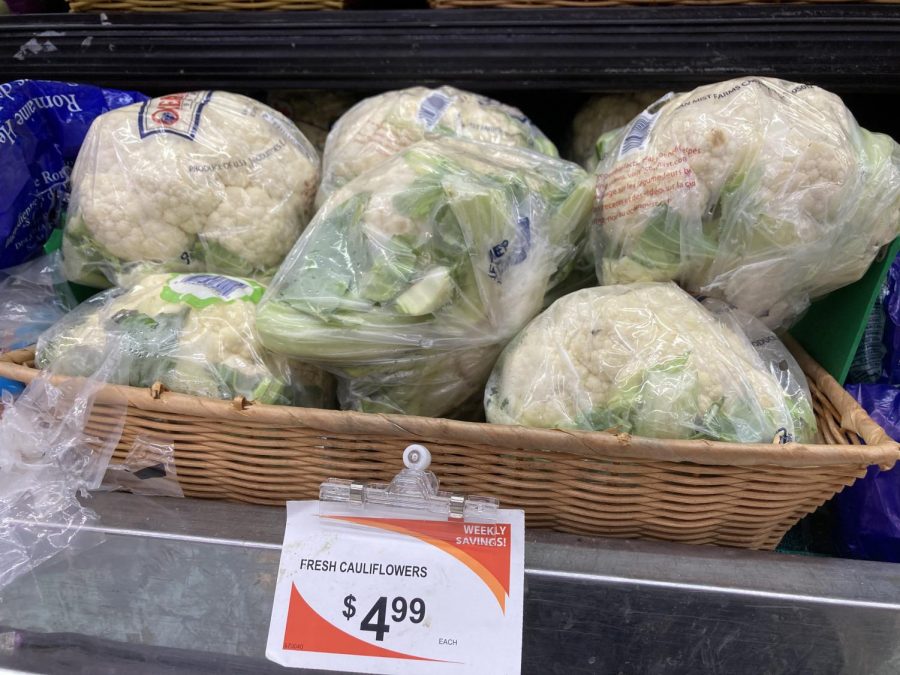Thanksgiving Tricks to Make Your Meal a Little Healthier
Cauliflower is a great healthy choice to add to your Thanksgiving table.
November 25, 2020
Thanksgiving is a holiday celebrated around the country with family, centered around making memories and having a grand feast. People can often feel bloated and guilty after their dinner and regret the things they put into their bodies. With the many appetizers, entrees and desserts traditional to the Thanksgiving meal, a few simple swaps can make it possible to enjoy the holiday season without worrying about calorie intake.
In addition to the traditional turkey, turning to a more plant-based approach towards appetizers and desserts is very beneficial to body health. The consumption of a plant-based diet has been proven to reduce the risk of colorectal cancer, the third most common cancer, and to support the immune system.
“Plants give your body what it needs to help fight off infection,” said Dr. Andrea Murray, Anderson health education specialist at the University of Texas Medical Center. In the context of conditions revolving around Thanksgiving, plant foods reduce inflammation in the body, helping the digestive system extract nutrients from food. Plant-based produce is rich in fiber which can lower cholesterol levels and stabilize blood sugar levels, aiding bowel and digestion management.
Mashed turnip is another alternative if you’re looking to skip the potatoes.
Plant-based Thanksgiving Meal Ideas
Cauliflower is a cruciferous vegetable that is rich in antioxidants, phytonutrients, fiber and choline, which helps improve cognitive functions such as learning and memory. It also avoids the added carbohydrates and starches found in potatoes.
Mashed turnip is another alternative if you’re looking to skip the potatoes. It has an omega-3 fatty acid and is rich in phosphorus, which helps to maintain the strength of your bones and teeth. Turnips act like phagocytic cells that filter the waste in your kidneys, reducing the risk of painful kidney stones.
To avoid brown gravy made from processed flour and lots of butter, you can use mushroom gravy to accompany the turkey. Mushroom intake is shown to have anti-aging effects and can reduce the risk of many neurodegenerative diseases such as Alzheimer’s, according to a study by Pennsylvania State University.
Turkey stuffing is often known for its high sodium and saturated fat intake levels. Traditional stuffing is loaded with bread crumbs, salt and butter which can be reimagined by using ingredients such as lentils, chestnuts, almonds, cranberries, hazelnuts and quinoa to make a nutrient-rich substitute.
Additionally, the nutrition staff at Mayo Clinic suggests subbing the traditional pumpkin or pecan pie for desserts such as honey-glazed sweet potatoes and squash pie; these recipes are high in selenium and vitamin C, protecting heart and thyroid health. By implementing this, many families can avoid white and brown sugar as well as thick flour crusts that add calories to the meal.
Advice for Thanksgiving Day
There are two key ways to help reduce your stress surrounding your Thanksgiving meal that involve moderation and eating routines, according to Lisa Sasson, a nutrition professor at New York University. Sasson encourages behavioral caution and balancing your plate and portion sizes. She emphasizes the importance of eating breakfast ahead of time so that your whole appetite is not saved for the main dinner, which may cause overeating and indigestion issues. Some of the best breakfast foods to eat include wholesome produce like nuts, salad with avocado, omelets, or oatmeal.
Thanksgiving can be a heavy day of drinking for some. Apple cider and wine can be very delicious, but if one is worried about excess calories, they may want to consider a simple substitute like a flavored (non-alcoholic) seltzer. Alcoholic beverages go through fermentation and distillation processes that result in containing 7 calories per gram plus additional calories when mixed with cola and tonic water. The average seltzer can trim excess calorie intake and help avoid a large amount of sugar or alcohol.
Load half the plate with non-starchy vegetables.
The most important step of eating a balanced meal is being mindful of portion size and color on your plate. Sasson’s rule of thumb is going heavy on grilled and roasted vegetables like beets, carrots and Brussels sprouts, which add color to your plate alongside the turkey. Load half the plate with non-starchy vegetables, and include a small ice-cream size scoop of starch-heavy vegetables like mashed or sweet potatoes.
After your meal, consider some physical activity, such as playing a game or taking a short walk with your family.
Most importantly, remember to enjoy these moments with your family and loved ones. Keeping the idea of moderation and healthy alternatives in mind, there is no need to worry if your Thanksgiving Day is a bit calorie-dense, just try to balance it out with physical activity afterward.














